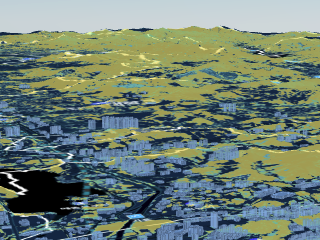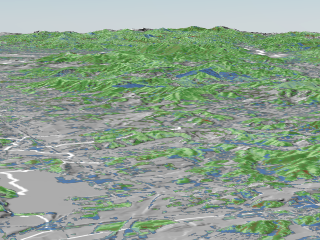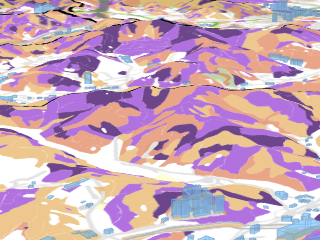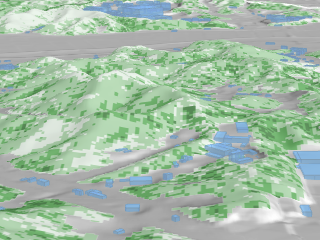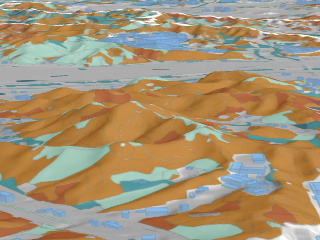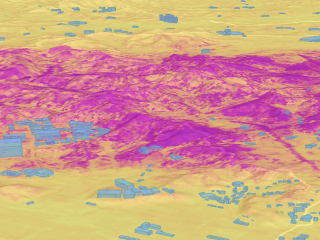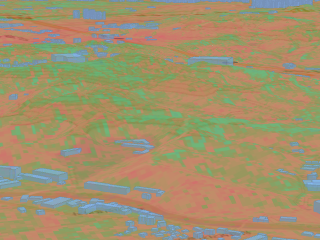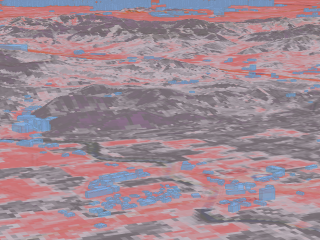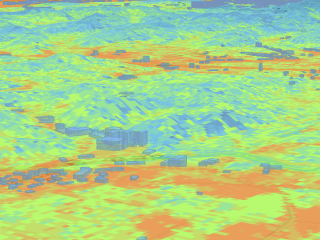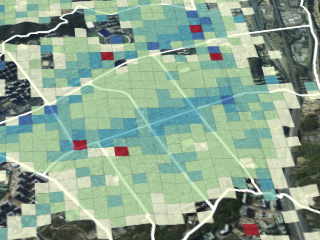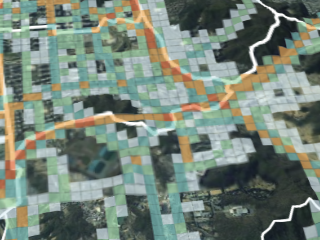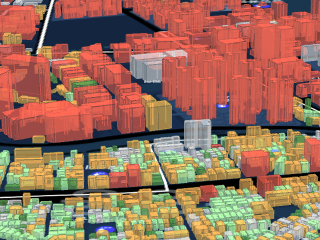
Carbon Spatial Information
This map analyzes carbon sinks and emission sources, allowing you to see regional carbon balance and changes at a glance.
Intuitively visualize regional information by analyzing carbon sinks and emission sources in detail.
Users can view the carbon balance of a specific region on a map and see how it changes over time.
This data provides useful information to policy makers, researchers, and the general public alike, and contributes to developing effective carbon management strategies for a sustainable future.
Carbon Absorption (trees)
Annual carbon absorption
Gyeonggi-do entire (million tCO2eq/yr-1)
0
MtCO2eq/yr-1Carbon absorption by trees in forests
Natural forests planted forests, etc. (million tCO2eq/yr-1)
0
MtCO2eq/yr-1Carbon absorption by trees in established green spaces
Parks, street trees, apartment landscaping green spaces, etc. (million tCO2eq/yr-1)
0
MtCO2eq/yr-1Carbon absorption by trees in cultivated land
Rice fields, fields, orchards, etc. (million tCO2eq/yr-1)
0
MtCO2eq/yr-1Vegetation carbon absorption in rivers and lakes
Reservoirs, embankment slopes, etc. (million tCO2eq/yr-1)
0
MtCO2eq/yr-1Climate Change Response Solution Based on High-Precision Carbon Sink Map with Satellite Images and BESS Model
The Gyeonggi-do carbon sink map is a precise spatial information service built at 10m high resolution to scientifically visualize the carbon absorption capacity of the local ecosystem. This map was developed through the integrated application of satellite image analysis, flux tower ground truth data, and the Biophysical Extrapolation System (BESS) model.
The map displays the carbon absorption of various ecosystems such as forests, agricultural lands, wetlands, and urban green spaces in Gyeonggi-do, classified by color. The mechanism-centered approach using the BESS model precisely models tree photosynthesis and ecosystem respiration, reflecting changes in carbon absorption according to seasonal changes and environmental conditions.
Carbon absorption was calculated based on vegetation index, leaf area index, land cover information, and meteorological data extracted from satellite images, and verified with Flux Tower data.
This map can be used in decision-making on climate change response policies, urban planning, and forest management, and serves as an educational tool for citizens to understand the current status of local carbon absorption. Through the climate platform, users can interactively explore carbon absorption information across Gyeonggi-do and check trends over time.
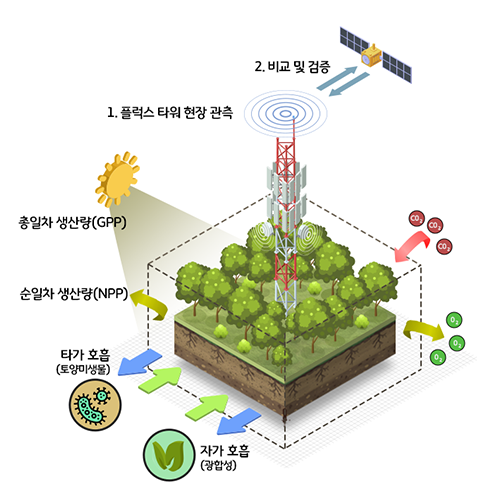
Gyeonggi-do Carbon Absorption Status
You can clearly understand the multifaceted carbon absorption statistics of Gyeonggi-do and 31 cities and counties with cartograms and responsive graphs.Gyeonggi-do
경기도 내 의 Carbon Absorption 비율
경기도 내 의 Carbon Absorption 순위
Legend [Unit 천tC/yr⁻¹]
Carbon Absorption (trees)
경기도 Carbon Absorption 통계
선택할 수 있는 데이터
Carbon Absorption (trees)
Carbon Absorption Data (kgC/yr⁻¹)
| 선택 문구 |
|---|
| 선택된 시군/읍면동 또는 데이터가 없습니다. 시군/읍면동 또는 데이터를 선택하여 주십시오. |
Carbon storage (Trees)
Total carbon storage of trees
Entire Gyeonggi-do (million tCO2eq)
0
MtCO2eqCarbon storage of trees in forests
Natural forests, planted forests, etc. (million tCO2eq)
0
MtCO2eqCarbon storage of trees in established green space
Parks, street trees, apartment landscaping green spaces, etc. (million tCO2eq)
0
MtCO2eqCarbon storage of trees in cultivated land
Rice fields, fields, orchards, etc. (million tCO2eq)
0
MtCO2eqVegetation carbon storage in rivers and lakes
Reservoirs, embankment slopes, etc. (million tCO2eq)
0
MtCO2eqClimate Change Response Solution Based on High-Precision Vegetation Carbon Map Constructed with 3D LiDAR and Satellite Data
The Gyeonggi-do Tree Carbon Map is a precise spatial information service built based on 3D information, and is a scientific visualization of the carbon storage capacity of trees in each region.
This map was created based on calculating biomass by tree species and individual trees using aerial point cloud data and high-resolution satellite images.
The map displays the carbon storage of various urban vegetation such as forests, park green spaces, and street trees in Gyeonggi-do, classified by color.
By acquiring tree information, including individual tree height, based on remote sensing data and applying relative growth equations for each tree species, we accurately reflected the actual scale of trees in forests and urban green spaces in Gyeonggi-do and calculated accurate carbon storage.
Most areas were created based on aerial LiDAR data, and border areas were based on high-resolution satellite images, and tree species information based on field surveys was reflected.
This map can be used for various decision-making, such as establishing Gyeonggi-dos climate change response policy, urban planning considering landscape and environmental factors, and forest management. It also guides citizens to recognize the current status of local vegetation carbon storage.
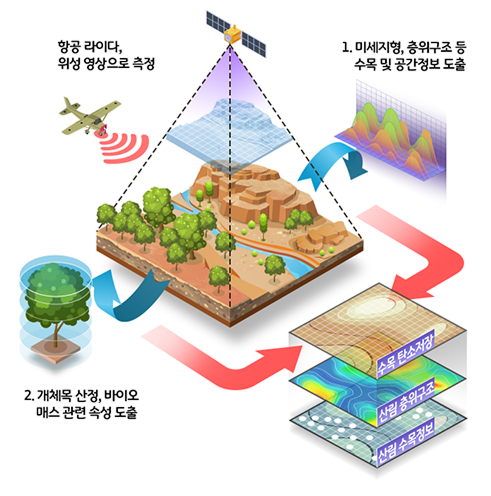
Status of carbon storage of trees in Gyeonggi-do
You can clearly understand the multifaceted tree carbon storage statistics of Gyeonggi-do and 31 cities and counties with cartograms and responsive graphs.Gyeonggi-do
경기도 내의 Carbon storage (Trees) 비율
경기도 내의 Carbon storage (Trees) 순위
Legend [Unit 천tC]
Carbon storage (Trees)
경기도 Carbon storage (Trees) 통계
선택할 수 있는 데이터
Carbon storage (Trees)
Carbon storage (Trees) Data (kgC)
| 선택 문구 |
|---|
| 선택된 시군/읍면동 또는 데이터가 없습니다. 시군/읍면동 또는 데이터를 선택하여 주십시오. |
Carbon Storage (Soil)
Total Soil Carbon Storage
Entire Gyeonggi-do (million tCO2eq)
0
MtCO2eqSoil Carbon Storage in Forests
Natural forests, planted forests, etc. (million tCO2eq)
0
MtCO2eq/㎢Soil Carbon Storage in Established Green Space
Parks, street trees, apartment landscaping green spaces, etc. (million tCO2eq)
0
MtCO2eqSoil Carbon Storage in Cultivated Land
Rice fields, fields, orchards, etc. (million tCO2eq)
0
MtCO2eqSoil Carbon Storage in Rivers and Lakes
Reservoirs, embankment slopes, etc. (million tCO2eq)
0
MtCO2eqHigh-Precision Carbon Thematic Map Based on Soil Measurements and Machine Learning at 1,500 Locations Across Gyeonggi-do, Implemented as a Spatial Solution to Respond to Climate Change
The Gyeonggi-do Soil Carbon Thematic Map is a precise spatial information service built with 10m high resolution to scientifically visualize soil carbon storage in the local ecosystem.
This map was developed by integrating ground truth surveys conducted at 1,500 locations across Gyeonggi-do during a single period in 2024, biotope-based sampling design, near-infrared spectroscopy-based soil carbon prediction model, and digital mapping techniques. The map shows soil carbon storage for various ecosystem types, including forests, agricultural lands, wetlands, and urban green spaces. It is visualized and displayed in color.
A prediction model was learned based on the carbon element analysis results and near-infrared spectrum data of the collected soil samples, and then a high-resolution soil carbon storage distribution throughout Gyeonggi-do was derived through Digital Soil Mapping technology that reflected the weather, topography, and vegetation information of the survey site.
This thematic map was created based on the largest-scale ground truth survey in a single period and reflects information on the carbon content of soil, the main carbon reservoir in terrestrial ecosystems. Therefore, it can be used to establish policies to respond to climate change, plan urban and forest management, and make strategic decisions to achieve carbon neutrality. It also serves as an educational tool for citizens to understand the carbon storage status of each region and recognize the need for carbon neutrality.

Status of Soil Carbon Storage in Gyeonggi-do
You can clearly understand the multifaceted soil carbon storage statistics of Gyeonggi-do and 31 cities and counties with cartograms and responsive graphs.Gyeonggi-do
경기도 내 의 Carbon Storage (Soil) 비율
경기도 내 의 Carbon Storage (Soil) 순위
Legend
Carbon Storage (Soil)
경기도 Carbon Storage (Soil) 통계
선택할 수 있는 데이터
Carbon Storage (Soil)
Carbon Storage (Soil) Data (kgC)
| 선택 문구 |
|---|
| 선택된 시군/읍면동 또는 데이터가 없습니다. 시군/읍면동 또는 데이터를 선택하여 주십시오. |
Carbon Emissions
Gyeonggi-do Carbon Emissions (Buildings, Transportation)
As of 2023
0
tonCO2eqCarbon Emissions from the Building Sector
As of 2023
0
tonCO2eqTransportation Sector Carbon Emissions (Based on VKT)
As of 2023
0
tonCO2eqCarbon Emissions Spatial Information
In order to respond to the climate crisis and achieve carbon neutrality, Gyeonggi-do provides a carbon space map that can accurately identify major greenhouse gas emissions. Carbon emissions arising from energy consumption and transportation activities are very unevenly distributed across regions, and detailed spatial-based analysis is essential to achieve the carbon neutrality goal. Accordingly, the Ministry of Land, Infrastructure and Transport established carbon emissions information for buildings and transportation, which are major carbon emissions areas, into spatial information in a 100m grid unit, and Gyeonggi-do established carbon emissions information on a building basis.
The building sector carbon emissions map is a spatialized data that converts electricity, gas, and district heating energy usage information provided by the Korea Real Estate Agency into a grid unit. This map analyzes energy consumption patterns and carbon emissions by month and year to identify high-emission areas and is used to establish regionally customized energy efficiency policies.
The transportation sector carbon emissions map is a transportation activity-based carbon map constructed by combining the road network, average speed by vehicle type, and vehicle registration status. We calculated VKT (vehicle traveling distance) using the Korea Transport Institutes high-precision road network map (Level 6), speed data, and vehicle registration data from e-Nara Index, and created a spatial map with 100m resolution by applying nationally recognized emission factors.
Gyeonggi-dos carbon emissions map intuitively identifies carbon emissions regions and provides key scientific basis for prioritizing energy transition, eco-friendly transportation, and establishing regional carbon neutral strategies.
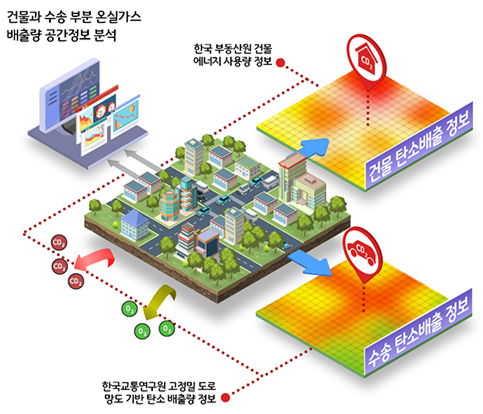
Gyeonggi-do Carbon Emissions (Buildings, Transportation) Status
You can clearly understand the multifaceted carbon emissions statistics of Gyeonggi-do and 31 cities and counties with cartograms and responsive graphs.Gyeonggi-do
경기도 내 의 Carbon Emissions 비율
경기도 내 의 Carbon Emissions 순위
Legend [Unit tCO₂eq]
Carbon Emissions (Buildings, Transportation)
경기도 Carbon Emissions (Buildings, Transportation) 통계
선택할 수 있는 데이터
Carbon Emissions (Buildings, Transportation)
Carbon Emissions Data (tonCO2eq)
| 선택 문구 |
|---|
| 선택된 시군/읍면동 또는 데이터가 없습니다. 시군/읍면동 또는 데이터를 선택하여 주십시오. |
Greenhouse Gas Inventory (Based on Direct Emissions VKT)
Direct Greenhouse Gas Emissions (Excluding LULUCF)
2022
0
GgCO₂eqEnergy
2022
0
GgCO₂eqIndustrial Processes and Product Production
2022
0
GgCO₂eqAgriculture
2022
0
GgCO₂eqLULUCF
2022
0
GgCO₂eqWaste
2022
0
GgCO₂eqGreenhouse Gas Inventory
The Starting Point of Gyeonggi-dos Climate Policy, Local Greenhouse Gas Emissions Management System
The local greenhouse gas inventory refers to a database that systematically researches and organizes the emissions and absorption of greenhouse gases generated at the local government level.
It is structured to quantitatively identify greenhouse gas emissions by region by comprehensively reflecting emissions from various sectors such as energy use, transportation, industry, waste, and agricultural and livestock products, as well as sinks such as forests and urban green spaces. This inventory is used as essential basic data to establish local-level carbon neutral policies and evaluate reduction implementation status.
Hosted by the National Greenhouse Gas Information Center (GIR), the greenhouse gas emissions of basic local governments, including 17 metropolitan local governments, are calculated and announced, and above all, this inventory is essential for establishing the local governments ‘Carbon Neutral Green Growth Basic Plan’. It serves as the basic data for establishing all plans, including setting greenhouse gas reduction goals, deriving reduction measures, and determining business priorities.
Local greenhouse gas emissions are largely divided into total emissions and management authority emissions. Total emissions include all greenhouse gas emissions generated within the region and encompass a variety of emission activities, including the power generation sector, industrial processes, buildings, transportation, and waste disposal. On the other hand, emissions with management authority refer only to emissions that local governments can directly manage or reduce through policy, and generally exclude the power generation sector (energy) and industrial sectors.
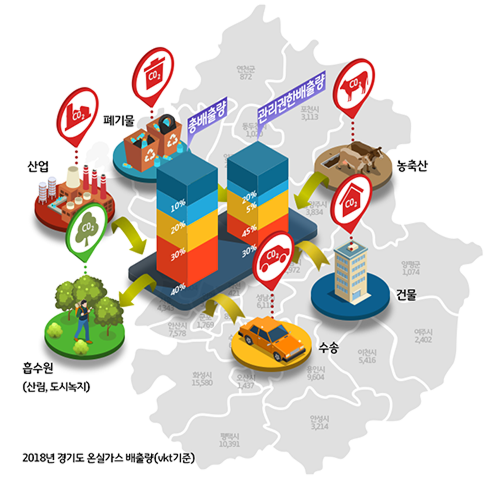
Gyeonggi-do Greenhouse Gas Inventory (Based on Direct Emissions)
You can clearly understand the multifaceted tree greenhouse gas inventory statistics of Gyeonggi-do and 31 cities and counties with cartograms and responsive graphs.Gyeonggi-do
경기도 내 의 Total Greenhouse Gas Emissions 비율
경기도 내 의 Total Greenhouse Gas Emissions 순위
Legend
Greenhouse Gas Inventory (직접배출량 기준)
경기도 Greenhouse Gas Inventory 통계
선택할 수 있는 데이터
Greenhouse Gas Inventory (직접배출량 기준)
Greenhouse Gas Inventory Data (GgCO₂eq)
| 선택 문구 |
|---|
| 선택된 시군/읍면동 또는 데이터가 없습니다. 시군/읍면동 또는 데이터를 선택하여 주십시오. |

